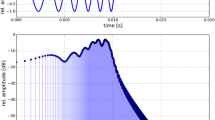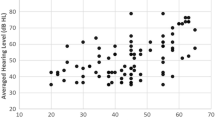Abstract
The current study explored differences among cervical vestibular evoked myogenic potentials (cVEMP) that were evoked by CE-chirp and click and tone pip in healthy controls, and tried to explain the differences of cVEMP between the three of them. Thirty normal volunteers were used as subjects for CE-chirp and click and tone-pip (Blackman pip) stimuli. The latency of P1, N1, peak-to-peak P1–N1 amplitude, and cVEMP interaural difference were obtained and analyzed. The response rates of cVEMP were 93 % for click and 100 % for both Blackman pip and CE-chirp, respectively. The P1 and N1 latencies of cVEMP evoked by CE-chirp were the shortest, followed by click, with Blackman pip the longest (F = 6,686.852, P < 0.001). All indices of cVEMP evoked by the three stimuli showed no significant difference between the left and right ears or between genders. cVEMP responses were significantly different between the three stimuli. Compared with the currently used stimulus, CE-chirp can evoke cVEMP with shorter latencies and demonstrates increased speed and reliability.


Similar content being viewed by others
References
Akin FW, Murnane OD, Panus PC, Caruthers SK, Wilkinson AE, Proffitt TM (2004) The influence of voluntary tonic EMG level on the vestibular-evoked myogenic potential. J Rehabil Res 41:473–480
Morufushi T, Curthuys IS (1997) Physiological and anatomicstudy of click-sensitive primary vestibular afferents in the guinea pig. Acta Otolaryngol 117:66–72
Rauch SD (2006) Vestibular evoked myogenic potentials. Curr Opin Otolaryngol Head Neck Surg 14:299–304
Cheng PW, Huang TW, Young YH (2003) The influence of clicks versus short tone bursts on the vestibular evoked myogenic potentials. Ear Hear 24:195–197
Huang TW, Cheng PW, Su HC (2006) The influence of unilateral versus bilateral clicks on the vestibular-evoked myogenic potentials. Otol Neurotol 27:193–196
Murofushi T, Matsuzaki M, Wu CH (1999) Short tone burst-evoked myogenic potentials on the sternoclideomastoid muscle: are these potentials also of vestibular origin? Arch Otolaryngol Head Neck Surg 125:660–664
Cal R, Bahmad JF (2009) Vestibular evoked myogenic potentials: an overview. Braz J Otorhinolaryngol 75:456–462
Ozdek A, Bayır O, Tatar EC, Korkmaz MH (2012) Comparison of tone burst versus logon stimulation for vestibular evoked myogenic potentials. Eur Arch Otorhinolaryngol 269:1425–1429
Bekesy G (1952) Direct observation of the vibrations of the cochlear partition under a microscope. Acta Otolaryngol 42:197–201
Shore SE, Nuttall AL (1985) High-synchrony cochlear compound action potentials evoked by rising frequency-swept tone bursts. J Acoust Soc Am 78:1286–1295
Lütkenhöner B, Kauffmann G, Pantev C, Ross B (1990) Verbesserung der Synchronisation auditorisch evozierter Hirnstammpotentiale durch Verwendung eines die cochleären Laufzeitunterschiede kompensierenden Stimulus (Increased synchronization of the auditory brainstem response obtained by a stimulus which compensates for the cochlear delay). Arch Otolaryngol 2:157–159
Kristensen SG, Elberling C (2012) Auditory brainstem responses to level-specific chirps in normal-hearing adults. J Am Acad Audiol 23:712–721
Elberling C, Callø J, Don M (2010) Evaluating auditory brainstem responses to different chirp stimuli at three levels of stimulation. J Acoust Soc Am 128:215–223
Elberling C, Don M (2008) Auditory brainstem responses to a chirp stimulus designed from derived-band latencies in normal-hearing subjects. J Acoust Soc Am 124:3022–3037
Dau T, Wegner O, Mellert V, Kollmeier B (2000) Auditory brainstem responses with optimized chirp signals compensating basilar-membrane dispersion. J Acoust Soc Am 107:1530–1540
Lin YH, Ho HC, Wu HP (2009) Comparison of auditory steady-state responses and auditory brainstem responses in audiometric assessment of adults with sensorineural hearing loss. Auris Nasus Larynx 36:140–145
Elberling C, Don M, Cebulla M, Stürzebecher E (2007) Auditory steady-state responses to chirp stimuli based on cochlear traveling wave delay. J Acoust Soc Am 122:2772–2785
Bohr A, Bernarding C, Strauss DJ, Corona-Strauss FI (2011) Effects of auditory selective attention on chirp evoked auditory steady state responses. Conf Proc IEEE Eng Med Biol Soc 2011:2013–2016
Krempaska S, Koval J (2012) The role of vestibular evoked myogenic potentials (VEMPs) in vestibulopathy diagnostics. Bratisl Lek Listy 113:301–306
Viciana D, Lopez-Escamez JA (2012) Short tone bursts are better than clicks for cervical vestibular-evoked myogenic potentials in clinical practice. Eur Arch Otorhinolaryngol 269:1857–1863
Elberling C, Don M (2010) A direct approach for the design of chirp stimuli used for the recording of auditory brainstem responses. J Acoust Soc Am 128:2955–2964
Akin FW, Murnane OD, Proffitt TM (2003) The effects of click and tone-burst stimulus parameters on the vestibular evoked myogenic potential (VEMP). J Am Acad Audiol 14:500–509
Cheng PW, Murofushi T (2001) The effects of plateau time on vestibular-evoked myogenic potentials triggered by tone bursts. Acta Otolaryngologica 121:935–938
Colebatch JG, Halmagyi GMH (1992) Vestibular evoked potentials in human neck muscles before and after unilateral vestibular deafferentation. Neurology 42:1635–1636
Colebatch JG (2001) Vestibular evoked potentials. Curr Opin Neurol 14:21–26
McNerney KM, Burkard RF (2011) The vestibular evoked myogenic potential (VEMP): air- versus bone-conducted stimuli. Ear Hear 32:6–15
Tsutsumi T, Komatsuzaki A, Noguchi Y, Tokano H, Kitamura K (2001) Postoperative vestibular-evoked myogenic potentials in cases with vestibular schwannomas. Acta Otolaryngol 121:490–493
Al-Sebeih K, Zeitouni A (2002) Vestibular-evoked myogenic potentials as a test of otolith function. Med Princ Pract 11:136–140
Takegoshi H, Murofushi T (2003) Effect of white noise on vestibular evoked myogenic potentials. Hear Res 176:59–64
Kondrachuk AV (2000) Computer simulation of the mechanical stimulation of the saccular membrane of bullfrog. Hear Res 143:130–138
Arts HA, Adams ME, Telian SA, El-Kashlan H, Kileny PR (2009)Reversible electrocochleographic abnormalities in superior canal dehiscence. Otol Neurotol 30:79–86
Modugno GC, Brandolini C, Cappello I, Pirodda A (2004) Bilateral dehiscence of the bony cochlear basal turn. Arch Otol Head Neck Surg 130:1427–1429
Gopen Q, Zhou G, Poe D, Kenna M, Jones D (2010) Posterior semicircular canal dehiscence: first reported case series. Otol Neurotol 31:339–344
Zhou G, Gopen Q, Kenna MA (2008) Delineating the hearing loss in children with enlarged vestibular aqueduct. Laryngoscope 118:2062–2066
Kerr AG (2005) Assessment of vertigo. Ann Acad Med Singapore 34:285–288
Perez N, Rama-Lopez J (2003) Head-impulse and caloric tests in patients with dizziness. Otol Neurotol 24:913–917
Author information
Authors and Affiliations
Corresponding author
Additional information
B.-C. Wang and Y. Liang contributed equally to this work.
Rights and permissions
About this article
Cite this article
Wang, BC., Liang, Y., Liu, XL. et al. Comparison of chirp versus click and tone pip stimulation for cervical vestibular evoked myogenic potentials. Eur Arch Otorhinolaryngol 271, 3139–3146 (2014). https://doi.org/10.1007/s00405-013-2724-5
Received:
Accepted:
Published:
Issue Date:
DOI: https://doi.org/10.1007/s00405-013-2724-5




